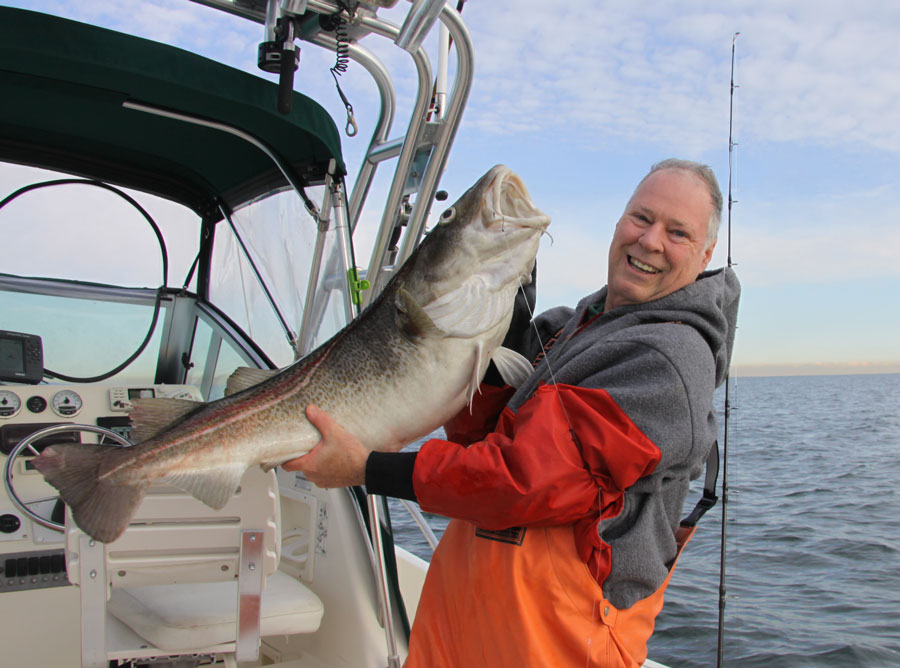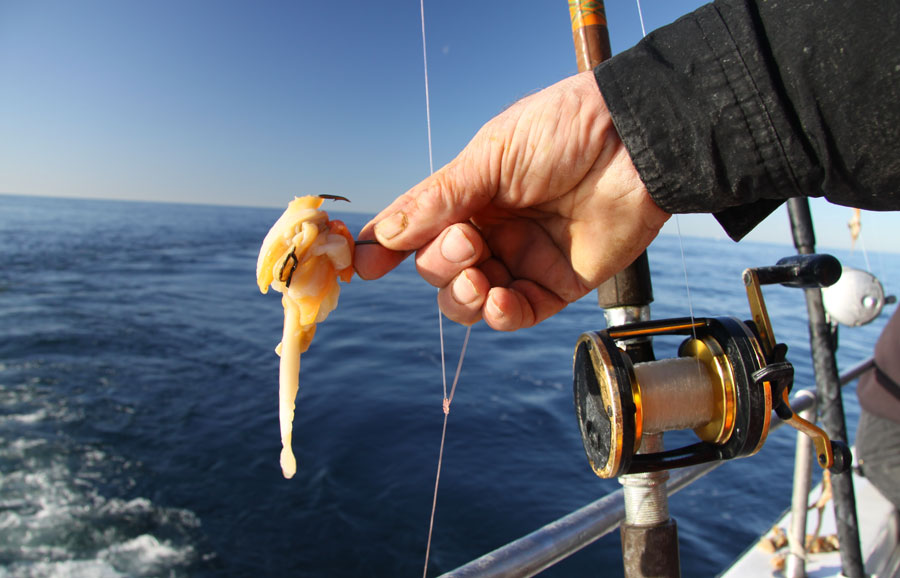By Tom Schlichter
Reports of fair to good codfish action have been the rule across Long Island this winter. Montauk, as is often the case, has seen the most consistent catches but some scores have also been recorded on vessels sailing from Shinnecock, Captree, and Freeport.
If you haven’t gotten in on the fun just yet, the time to act is now. While the baccala are likely to stick around into March, you just never know when these fish will pack up and leave. Better to be safe than sorry and get out there as soon as possible. True, March codfish action can be super at times, but February tends to be more reliable as long as the fleet can get offshore on a regular basis.
Naturally, you’ll want choose a day with calm winds and mild temperatures when setting your sights on Mr. Whiskers. Be sure to also dress warm and get to the boat early in order to guarantee a choice spot along the rail in the bow or stern on pay-to-play vessels. It also helps to plan weekday rather than weekend trips, if possible. Mid-week adventures tend to have more elbow room, fewer competing boats jockeying for position over prime bottom, and wrecks that have had a day or two to re-stock after weekend poundings.
Once you finally set sail – no matter what day of the week – resolve to keep things simple. Cod aren’t overly complicated fish, especially when you have a good captain at the helm. Focus on getting things right at the terminal end of your line and the odds are good you’ll return with enough fillets for several delicious dinners.
Waist High
Take rigging-up, for example. There are several popular terminal set-ups from which to choose these days including a basic bottom rig, high-low rig, snafu rig and jig rig among others. Add to each of these the option of tying in one or more teasers of various types and you’ve got a lot to consider.
When bait-fishing for cod, be it with cut strips of skimmer clam, herring chunks or even white crabs left over from blackfish season, I like a single hook rig the best. It’s important to note, however, that codfish don’t hang as tight to structure or the sea floor as blackfish, so you’ll want to position the hook higher above the bottom than you would for ‘tog.
I’ll usually use a dropper loop to tie a 6/0 sproat or octopus style hook into a five-foot length of 40-to 60-pound test mono leader well above an 8- to 10-ounce bank sinker. Tie the hook in about waist high. Note that it doesn’t matter if you are a little taller or shorter than your rail mates because the sweet spot for cod is between 2-1/2 and 3-1/2 feet above the bottom. Place the hook at your own waist height and you’ll never have to guess about being in the strike zone.
A single-hook rig is my preference because I like to concentrate on cod specifically. Some anglers prefer to hedge their bets with mixed-bag catches that include ling, silver eels, conger eels, bergalls and any number of additional cellar dwellers. If you want more variety in your game, use a dropper loop to tie in a second hook six inches above the sinker. A size 4/0 is about right for these additional treats while still being big enough to stick a decent codfish if it decides to grab hold.
The downside to using two hooks with bait rigs for cod is that all the time spent reeling up smaller bottom feeders decreases your odds of hooking pool contenders. The biggest cod, you see, are often a bit slow to respond to a freshly presented bait. With one hook set well off the bottom, they have a good chance to be first in line. With two hooks, one being tight to the bottom, the smaller scavengers have a clear advantage.
Do The Herring Jig
Bait-fishing is the usual approach when the cod schools are scattered, holding near sticky structure or simply off their bite. If herring arrive on the scene, however, cod will often school tightly and pursue the big, silvery baitfish over more open bottom. When they do, diamond jigs shine bright.
If you’ve used diamond jigs for stripers, you already know the routine. The big difference when targeting cod is that you’ll need bigger jigs to get to the bottom quickly. Choose an 8- to 12-ounce hammered diamond jig in silver and tip it with a hot pink, red or bright orange jelly worm or soft-plastic trailer. Go ahead and add a bright colored teaser an arm’s length above the jig, too. Since you’ll be actively working this rig and not allowing it to sit on the bottom as you would a clam bait, the number of smaller scavengers you’ll encounter should be minimal.
Another key to jigging cod, as with jigging stripers, is to work the lure at a slow to moderate speed. As opposed to bluefishing, where a fast retrieve is needed to excite your target, cod jigging calls for a steady, comfortable pace. Drop the lure all the way to the bottom, crank up eight to ten turns of the reel handle and then disengage the reel and allow your lure to drop to the bottom again. Repeat the process over and over, setting the hook at the slightest bump or sensation of extra weight.
Tough and Stringy
When it comes to codfish bait, skimmer clam reigns supreme. It is, however, possible to offer even a trophy-class codfish too much of a good thing. Many anglers string three, four or even more strips of clam together in the hopes of attracting big fish with a huge pile of bait. That rarely works, however, since a big glob of bait just hangs on the hook with little or no natural motion.
Rather than worry about your bait being big, make it point to ensure that every piece of clam you drop to the bottom is properly skewered on the hook. Start by choosing just one or two pieces of skimmer that have both a tough rim section to hold the hook as well as some stringy ribbon lengths that will wave enticingly in the current. Pass the point and barb though the tough section at least twice and allow the rest to simply hang free.
All you need is one or two pieces of skimmer on each hook. That gives a cod a clean target and ensures the hook point will remain clear so it can easily dig in when you lift the rod after feeling a bite.
From that point on, the rest is easy. Just reel up smooth and steady with the pool fish at the end of your line, count your winnings on the way home, and remember to tip the mate at the end of the day. When the February cod bite is in full swing, it’s as simple as that.
By Tom Schlichter











